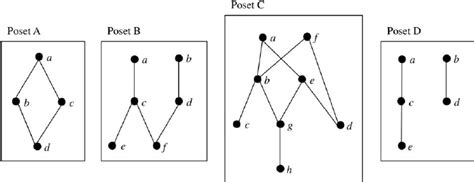Chapter 8 Extremal Set theory
Recall from Section 5.1 that a poset is a set with a binary relation that is reflexive and anti-symmetric. The binary relation is called as partial order and it is said to be a total order or linear order if any two elements are comparable. Further recall that a chain in a poset is a totally ordered set of and an antichain is a subset where no two elements are comparable. We will prove some results on chains and anti-chains complementing the results in Section 5.1. An easy visual representation of posets is via the Hasse diagram as follows:

We start with the more famous version of Dilworth’s decomposition theorem .
Theorem 8.1 (R. Dilworth (1950)).
Let be a finite poset. Let be the minimum number of disjoint chains whose union is and let be the maximum number of elements in an antichain of . Then .
Proof.
(H. Tverberg, 1967) Let be an anti-chain. Since each can belong to at most one chain, each must belong to a different chain and hence we need at least disjoint chains to cover i.e., .
For the other inequality, we use induction on . If there is nothing to prove. Let and let be a maximal chain in .
If the maximum number of elements in an anti-chain in is at most , then by induction hypothesis is a union of at most disjoint chains and so is a union of at most disjoint chains and so . The proof is complete.
Suppose, there is an anti-chain in . Observe that this is a maximal anti-chain. Now define Define analogously using . Since is a maximal chain, . Also by maximality of , the maximum (resp. minimum) element of does not belong to (resp. ). Thus by induction hypothesis both and are union of disjoint chains and respectively with . Since ’s form an anti-chain, is the maximum element in and minimum element in . Thus is also a chain and further ’s are disjoint. Hence and as required. ∎
Recall Dilworth’s earlier theorem (Theorem 5.2) Mirsky’s lemma (Lemma 5.3), which can both be considered as dual to the Dilworth’s theorem.
Exercise(A) 8.2.
Prove Hall’s matching theorem using Dilworth’s theorem.